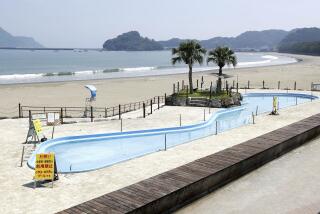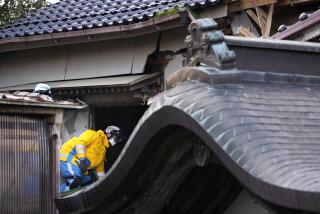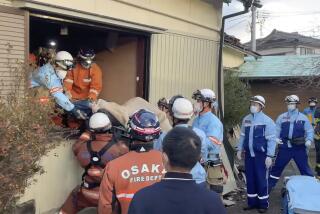Kobe Residents Begin Returning to Work, School
- Share via
KOBE, Japan — With electricity available almost everywhere and water at last reaching half the homes, this earthquake-devastated city took a first step toward normalcy today as crowds of commuters headed to work and children returned to school.
“People bringing food from Osaka are coming in by train, buses are running to Nishinomiya (a nearby city where direct trains to Osaka are functioning), and boats are available to Osaka. So I felt I had to go to work,” Masami Hamaguchi, 49, an auto company executive, said as he headed to work. “They didn’t ask me. But today’s Monday, so anyway, I should show up.”
Weekend rains had passed without triggering serious landslides, but skies were still gray and it was drizzling in some areas. As crews continued to dig bodies out of the rubble and clear away debris blocking streets, the attention of many survivors began to turn from the shock of last week’s tragedy to the arduous task of rebuilding. Classes even resumed in about half the city, although in the worst-hit districts, pupils offered a one-minute silent prayer for quake victims and went home after teachers noted who had come.
Kobe’s wholesale fish market opened for the first time in seven days, but only a tenth of the normal supplies of marine products were put on sale.
“Yesterday was the first time I had contact from my company,” Yotaro Konishi, 56, said after leaving the disaster relief center at the Ninomiya Elementary School near downtown Kobe. “Today, we’re all gathering at 10 a.m. at the office. They want to check who is OK.”
Minor aftershocks, however, kept the city on edge. “They’ve been predicting a big aftershock,” 50-year-old Masanori Namba said as he waited on a Kobe train platform. “When I felt an aftershock last night, I was frightened. I thought, ‘Oh, it’s come.’ But it was over quickly, and it wasn’t so big.”
Gov. Toshitami Kaihara warned Sunday that rehabilitation measures will be needed not just for refugees but for all 2 million survivors in his Hyogo prefecture, which suffered the brunt of the death and destruction. He warned that help for quake refugees and other residents will be needed “not just next week and next month but into the future.”
But Kaihara said he also has “a dream” of “repaying” victims of the disaster by reconstructing Hyogo into “a disaster-resistant model for all of Japan” and a prefecture in which “the infirm and the old, the urbanite and the country dweller can live in harmony.”
Chief Cabinet Secretary Kozo Igarashi, speaking on NHK Television, confirmed Sunday that major financial assistance from the national government will be forthcoming. He said that “of course” Japan’s government will compile a special budget to finance reconstruction. In a policy speech to Parliament on Friday, Prime Minister Tomiichi Murayama had said only that the government would “study” enacting a supplementary budget.
“Kobe people are very energetic,” said Namba, who works for a resort hotel company. “With everyone’s strength, I think it will be restored relatively quickly.”
Namba said a more disaster-proof city should be built.
“Old houses completely collapsed and blocked the narrow roads, so the fire engines couldn’t get through. And the water supply was cut off,” Namba said. “That’s why they had the big fires. So they should widen the roads and build a water system in a way that it won’t be cut off, even in an earthquake of this scale.”
But such changes will not be easy.
“People are talking about widening the roads and making a more modern city,” said Takuya Yasuoka, a 65-year-old liability insurance office executive. “But people own land along those streets. It would cost a lot of money to widen the roads. Is the country going to pay? Are they going to provide land elsewhere? Japan is a country with too many people and not enough land.”
The number of refugees living in more than 1,000 emergency relief centers in the disaster region remained at nearly 300,000.
By afternoon today, the toll stood at 4,984 confirmed dead and 159 reported missing, with 26,120 others injured. More than 52,500 buildings and homes were destroyed or damaged beyond repair.
A 74-member contingent of U.S. Marines flew in from Okinawa on Sunday to set up 20 large, general-purpose tents in city parks. “It felt real good . . . to do our part to help out,” said Gunnery Sgt. Stephen Ruvio of the 3rd Division. The U.S. military in Japan has offered to provide any assistance that the Japanese request, but so far the government has asked only for a shipment of blankets and now the tents.
Igarashi said restoration of gas service to 852,000 households will take up to 1 1/2 months. Kobe, a major port city of 1.5 million and the capital of Hyogo prefecture, can expect water supplies to return completely by the end of January, but 660,000 households in other cities, including Nishinomiya and Ashiya, will have to wait a month more, he added.
Kaihara said that the emergency plans that Hyogo prefecture had prepared for earthquakes had proved worthless in the face of the extensive damage. “With the sacrifice of more than 4,900 lives, all of these plans need revision,” he said.
It had not yet been determined exactly how many of the nearly 300,000 refugees staying in unheated school gymnasiums and public halls need new housing. Many of the evacuees said they left their homes because they were afraid to stay or because they lacked electricity, water and gas.
Nishinomiya Mayor Junzo Baba said on NHK that 17,000 homes and apartments in his city alone can no longer be used. This morning, officials in his city received 2,055 applications--with hundreds of refugees still in line--for 1,250 living units that officials said could be made available. Allocations were to be made in a drawing.
On the same TV program, Construction Minister Koken Nozaka said the government so far had firmed up plans to provide only 15,000 living units, including 10,000 temporary homes to be built on government property.
Without spelling out details, Nozaka said he plans to ask “civilians” to help house the refugees temporarily. With more bus and train transportation routes out of the city functioning now, it also has become easier for refugees to take up temporary residence with relatives in neighboring Osaka and other areas of Japan.
Insurance executive Yasuoka said he was 8 years old when a flood hit Kobe that “was worse than this.” “Then, in 1945, there were the air raids. I remember it all. This is the third time for me. Through these experiences, I can cope with this situation now. I don’t have much feeling that someone has to fix things up for us. We have to do it ourselves.”
The Meteorological Agency urged residents to remain on alert for landslides. Rain fell for 13 hours Sunday, for the first time since Tuesday’s quake, but there were no serious landslides.
The magnitude of the temblor was reported as 7.2 by the Japanese but was measured at 6.8 by scientists at the U.S. Geological Survey in Golden, Colo.
Kazuo Oike, a Kyoto University earthquake expert, said the “probability” of an aftershock as big as a magnitude of 6.0 is “very high.” Seven of the last eight large earthquakes in Japan produced such an aftershock, he noted. Early today, three aftershocks with a magnitude of up to 4.0 shook the area.
As the end of the first week of refugee life approached at the relief centers, stoicism continued to prevail.
Many refugees complained Sunday that relief goods were still in scant supply. But they said food supplies were coming in regularly.
Isamu Yano, 33, said he lost his mother when the roof of their home collapsed. Nine neighbors, he said, were buried in the rubble of their homes after the quake, and six of them were rescued “as people in the neighborhood left their own homes to come to help.”
“I wanted my mother to be pulled out. But there were no cries from her. We gave priority to places where there were cries for help,” he said, breaking into tears. “Those neighbors, the volunteers at this relief center, friends who came to visit me from far away--we all became a community.”
* RECOVERY EFFORTS IN JAPAN: Kobe is still reeling, but some businesses are reopening. D1
More to Read
Sign up for Essential California
The most important California stories and recommendations in your inbox every morning.
You may occasionally receive promotional content from the Los Angeles Times.










